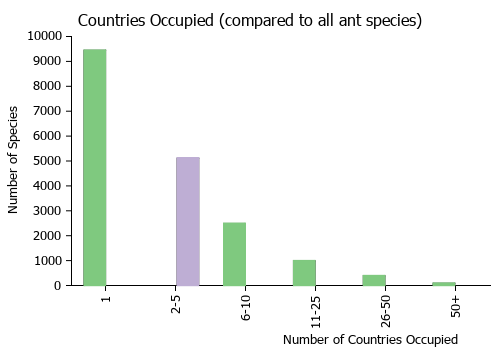Pseudomyrmex rochai
| Pseudomyrmex rochai | |
|---|---|

| |
| Scientific classification | |
| Kingdom: | Animalia |
| Phylum: | Arthropoda |
| Class: | Insecta |
| Order: | Hymenoptera |
| Family: | Formicidae |
| Subfamily: | Pseudomyrmecinae |
| Genus: | Pseudomyrmex |
| Species: | P. rochai |
| Binomial name | |
| Pseudomyrmex rochai (Forel, 1912) | |
Identification
Distribution
Latitudinal Distribution Pattern
Latitudinal Range: 10.35° to -23.45°.
| North Temperate |
North Subtropical |
Tropical | South Subtropical |
South Temperate |
- Source: AntMaps
Distribution based on Regional Taxon Lists
Neotropical Region: Brazil (type locality), Colombia, Ecuador, Panama.
Distribution based on AntMaps
Distribution based on AntWeb specimens
Check data from AntWeb
Countries Occupied
| Number of countries occupied by this species based on AntWiki Regional Taxon Lists. In general, fewer countries occupied indicates a narrower range, while more countries indicates a more widespread species. |

|
Estimated Abundance
| Relative abundance based on number of AntMaps records per species (this species within the purple bar). Fewer records (to the left) indicates a less abundant/encountered species while more records (to the right) indicates more abundant/encountered species. |

|
Biology
Castes
Images from AntWeb
   
| |
| Syntype of Pseudomyrmex rochai. Worker. Specimen code casent0907553. Photographer Will Ericson, uploaded by California Academy of Sciences. | Owned by MHNG, Geneva, Switzerland. |
Nomenclature
The following information is derived from Barry Bolton's Online Catalogue of the Ants of the World.
- rochai. Pseudomyrma rochai Forel, 1912g: 27 (w.) BRAZIL. [Pseudomyrma rochai Forel, 1908e: 65. Nomen nudum.] Combination in Pseudomyrmex: Kempf, 1972a: 222.
Description
References
- Forel, A. 1912h. Formicides néotropiques. Part IV. 3me sous-famille Myrmicinae Lep. (suite). Mém. Soc. Entomol. Belg. 20: 1-32 (page 27, worker described)
- Franco, W., Ladino, N., Delabie, J.H.C., Dejean, A., Orivel, J., Fichaux, M., Groc, S., Leponce, M., Feitosa, R.M. 2019. First checklist of the ants (Hymenoptera: Formicidae) of French Guiana. Zootaxa 4674, 509–543 (doi:10.11646/zootaxa.4674.5.2).
- Kempf, W. W. 1972b. Catálogo abreviado das formigas da regia~o Neotropical. Stud. Entomol. 15: 3-344 (page 222, Combination in Pseudomyrmex)
References based on Global Ant Biodiversity Informatics
- Adams B. J., S. A. Schnitzer, and S. P. Yanoviak. 2016. Trees as islands: canopy ant species richness increases with the size of liana-free trees in a Neotropical forest. Ecography doi: 10.1111/ecog.02608
- Adams B. J., S. A. Schnitzer, and S. P. Yanoviak. 2019. Connectivity explains local ant community structure in a Neotropical forest canopy: a large-scale experimental approach. Ecology 100(6): e02673.
- Calle Z., N. Henao-Gallego, C. Giraldo, and I. Armbrecht. 2013. A Comparison of Vegetation and Ground-dwelling Ants in Abandoned and Restored Gullies and Landslide Surfaces in the Western Colombian Andes. Restoration Ecology 21(6): 729-736.
- Forel A. 1908. Catálogo systemático da collecção de formigas do Ceará. Boletim do Museu Rocha 1(1): 62-69.
- Forel A. 1912. Formicides néotropiques. Part IV. 3me sous-famille Myrmicinae Lep. (suite). Mémoires de la Société Entomologique de Belgique. 20: 1-32.
- Franco W., N. Ladino, J. H. C. Delabie, A. Dejean, J. Orivel, M. Fichaux, S. Groc, M. Leponce, and R. M. Feitosa. 2019. First checklist of the ants (Hymenoptera: Formicidae) of French Guiana. Zootaxa 4674(5): 509-543.
- Kempf, W.W. 1972. Catalago abreviado das formigas da regiao Neotropical (Hym. Formicidae) Studia Entomologica 15(1-4).
- Longino J. T., J. Coddington, and R. K. Colwell. 2002. The ant fauna of a tropical rain forest: estimating species richness three different ways. Ecology 83: 689-702.
- Lopes M. C., G. P. A. Lamarre, C. Baraloto, P. V. A. Fine, A. Vincentini, and F. B. Baccaro. 2019. The Amazonas-trap: a new method for sampling plant-inhabiting arthropod communities in tropical forest understory. Entomologia Experimentalis et Applicata https://doi.org/10.1111/eea.12797
- Navarro, E.V. Vergara, H. Echavarria Sanchez, F.J. Serna Cardona. 2007. Hormigas (Hymenoptera: Formicidae) asociadas al arboretum de la Universidad Nacional de Colombia, sede Medellin. Boletín Sociedad Entomológica Aragonesa 40:497-505.

